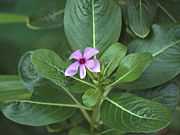Catharanthus roseus
| Madagascar rosy periwinkle | |
|---|---|
| | |
| Scientific classification | |
| Kingdom: | Plantae |
| (unranked): | Angiosperms |
| (unranked): | Eudicots |
| (unranked): | Asterids |
| Order: | Gentianales |
| Family: | Apocynaceae |
| Genus: | Catharanthus |
| Species: | C. roseus |
| Binomial name | |
| Catharanthus roseus (L.) G.Don | |
| Synonyms | |
| |
| Wikimedia Commons has media related to Catharanthus roseus. |
Catharanthus roseus, commonly known as the Madagascar periwinkle or rosy periwinkle, is a species of Catharanthus native and endemic to Madagascar. Other English names occasionally used include Vinca, Cape periwinkle, rose periwinkle, rosy periwinkle, and "old-maid".[1][2] It was formerly classified in the Vinca genus as Vinca rosea.
Synonyms
Two varieties are recognized
- Catharanthus roseus var. roseus
- Synonymy for this variety
- Catharanthus roseus var. angustus (Steenis) Bakh. f.[8]
- Synonymy for this variety
Description
It is an evergreen subshrub or herbaceous plant growing 1 m tall. The leaves are oval to oblong, 2.5–9 cm long and 1–3.5 cm broad, glossy green, hairless, with a pale midrib and a short petiole 1–1.8 cm long; they are arranged in opposite pairs. The flowers are white to dark pink with a darker red centre, with a basal tube 2.5–3 cm long and a corolla 2–5 cm diameter with five petal-like lobes. The fruit is a pair of follicles 2–4 cm long and 3 mm broad.[11][12][13][14]
In the wild, it is an endangered plant; the main cause of decline is habitat destruction by slash and burn agriculture.[15] It is also however widely cultivated and is naturalised in subtropical and tropical areas of the world.[11]
Cultivation and uses
The species has long been cultivated for herbal medicine and as an ornamental plant. In Ayurveda (Indian traditional medicine) the extracts of its roots and shoots, though poisonous, is used against several diseases. In traditional Chinese medicine, extracts from it have been used against numerous diseases, including diabetes, malaria, and Hodgkin's lymphoma.[12] Many of the vinca alkaloids were first isolated from Catharanthus roseus. The substances vinblastine and vincristine extracted from the plant are used in the treatment of leukemia [15] and Hodgkin's lymphoma.
This conflict between historical indigenous use, and recent patents on C.roseus-derived drugs by western pharmaceutical companies, without compensation, has led to accusations of biopiracy.[16]
It can be dangerous if consumed orally.[15] It can be extremely toxic, and is cited (under its synonym Vinca rosea) in Louisiana State Act 159.
As an ornamental plant, it is appreciated for its hardiness in dry and nutritionally deficient conditions, popular in subtropical gardens where temperatures never fall below 5 °C to 7 °C, and as a warm-season bedding plant in temperate gardens. It is noted for its long flowering period, throughout the year in tropical conditions, and from spring to late autumn, in warm temperate climates. Full sun and well-drained soil are preferred. Numerous cultivars have been selected, for variation in flower colour (white, mauve, peach, scarlet and reddish-orange), and also for tolerance of cooler growing conditions in temperate regions. Notable cultivars include 'Albus' (white flowers), 'Grape Cooler' (rose-pink; cool-tolerant), the Ocellatus Group (various colours), and 'Peppermint Cooler' (white with a red centre; cool-tolerant).[11]
C. roseus is used in plant pathology as an experimental host for phytoplasmas.[17] This is because it is easy to infect with a large majority of phytoplasmas, and also often has very distinctive symptoms such as phyllody and significantly reduced leaf size.[18]
Chemical constituents
Rosinidin is an anthocyanidin pigment found in the flowers of C. roseus.[19]
Other names
C. roseus is known as "Noyon Tora"(Assamese:নয়নতৰা)in Assamese,"noyontara" (Bengali: নয়নতারা) in Bengali, sadaphuli (Marathi: सदाफुली) in Marathi, "Tapak Dara" in Indonesian, boa-noite ("good night") and maria-sem-vergonha ("shameless maria", name shared with Impatiens and Thunbergia alata) in Portuguese (American), vinca-de-madagáscar, vinca-de-gato ("cats' vinca"), vinca-branca (white vinca), vinca or boa-noite in Portuguese (European), vinca del Cabo, vinca rosa ("pink vinca") or vinca rosada ("roseous vinca") in Spanish, putica ("little whore") in Venezuela and nithyakalyani in Tamil (Tamil: நித்யகல்யாணி பூ).Barmasi in Gujarati.
Photos
-
Vinca From a garden at Cox's_Bazar Bangladesh
-
Flower bud in West Bengal, India.
-

Catharanthus roseus in Pakistan
-

Grown in Malaysia
-

Flower plant raised in India Temples
-

Fruits and seeds
-
White rosy periwinkle
-
Pacifica Burgundy Halo - Madagascar Periwinkle
References
- ↑ Flora of Madagascar: Catharanthus roseus
- ↑ Germplasm Resources Information Network: Catharanthus roseus
- ↑ Steenis ex Bakhuizen f., Blumea 6: 384. 1950.
- ↑ G.Don, Gen. Hist. 4(1): 95. 1837.
- ↑ G.Don Gen. Hist. 4(1): 95. 1837.
- ↑ Markgr., Adansonia, ser. 2. 12: 222. 1972.
- ↑ Woodson, N. Amer. Fl. 29: 124. 1938.
- ↑ Bakh. f.Blumea 6 (2): 384. 1950.
- ↑ Markgr. Adansonia, ser. 2. 12: 222. 1972.
- ↑ Steenis Trop. Nat. 25: 18. 1936.
- ↑ 11.0 11.1 11.2 Huxley, A., ed. (1992). New RHS Dictionary of Gardening. Macmillan ISBN 0-333-47494-5.
- ↑ 12.0 12.1 Flora of China: Catharanthus roseus
- ↑ College of Micronesia: Catharanthus roseus
- ↑ Jepson Flora: Catharanthus roseus
- ↑ 15.0 15.1 15.2 DrugDigest: Catharanthus roseus
- ↑ Karasov, C. (2001). "Who Reaps the Benefits of Biodiversity?". Environmental Health Perspectives (Environmental Health Perspectives, Vol. 109, No. 12) 109 (12): A582–A587. doi:10.2307/3454734. JSTOR 3454734. PMC 1240518. PMID 11748021.
- ↑ C. Marcone, A. Ragozzino, E. Seemuller (1997). "Dodder transmission of alder yellows phytoplasma to the experimental host Catharanthus roseus (periwinkle)". Forest Pathology 27 (6): 347–350. doi:10.1111/j.1439-0329.1997.tb01449.x.
- ↑ Chung-Jan Chang (August 12, 1997, Rochester, NY). "Pathogenicity of Aster Yellows Phytoplasma and Spiroplasma citri on Periwinkle". 89th Annual Meeting of the American Phytopathological Society. Check date values in:
|date=(help) - ↑ Toki K, Saito N, Irie Y, Tatsuzawa F, Shigihara A, Honda T (March 2008). "7-O-Methylated anthocyanidin glycosides from Catharanthus roseus". Phytochemistry 69 (5): 1215–9. doi:10.1016/j.phytochem.2007.11.005. PMID 18164044.





